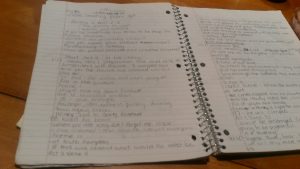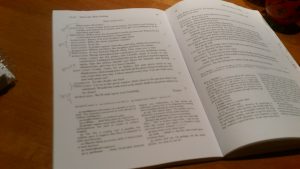When reading the text of Shakespeare I have found the over the years practice makes perfect. I am a drama major and due to this fact I have read a lot of Shakespeare over the last four years. This has influenced heavily how I analyze the text as well as the movies they inspire. It is because I have discussed them heavily in a theatrical sense that I often view movies in that fashion. I see the shots as a scene on stage. When it comes to the text I often break it down as an actor if I get stuck. The practice of reading it on a regular basis has given me the opportunity to break it down a bit less and just enjoy the text. While still breaking it down when necessary.
I have a theatrical outlook on these practices which makes them quite similar in my note taking. However, there is a difference in the volume of notes I take. I find myself taking more notes on films I watch versus the text I read. This is due to the fact that the medium is indeed quite different from the stage. The terminology is different and therefor I find that is were the bulk of my notes come from. My application of these terms to what I see going on in the scene. If I can apply the terms to the visual I see on the screen they better stay in my mind. I also use umbrella terms often in my film notes. Terms regarding themes, mood and style. These terms help jog my memory as to the specifics of the clip when I am looking back on my notes. There are often notes on what emotions I experienced while watching the clip or film. This again is a tactic to help me recall how I felt while watching. My film notes are much more vague and inclusive when compared to my notes on text.

I am not one to write excessively in the margins of the script. I find my thoughts become cluttered when I am trying to reread the text if my notes are in the margins. The notes I do take are in a separate note book. I am much more specific in my note taking when breaking down text versus film. I take a line or two and analyse what the character is trying to say. This is where the theatrical practices come in. I break the speech in to beats and look at it from the point of view of an actor potentially playing this role. Beats are couplets of lines that contain the same theme. When the theme or topic changes a new beat begins. They can be as small as two lines and even up to a paragraph. I find by doing this if helps me follow the arc of the speech better. In the case of a long soliloquy it helps to not get lost in the sheer volume of words used. By using beats it breaks the text down into more attainable segments. It also helps me as a reader follow the emotional arc of the words and character.

The notes I take in my note book are specific in that they are often matched to lines the script. They are organized by act and scene in order to keep the plot organized. They often contain comparisons to something I may understand better than what is referenced in the text. My notes also have synonyms to the words in the original Shakespearean language. This is another tool to help me process and understand what is happening in the scene. I generally only take these notes and break these scenes down into beats when I am having issues understanding the scene and the text. If I find myself stumbling on the words I will stop and take the time to break it all down. This is also why I find I have more notes about film.
I will take notes during the duration of a film where as I will only take notes during specific times when reading Shakespeare. Both types of notes involve a theatrical aspect weather it be viewing it as a play before a movie. Or rather breaking down the text you read as if your were an actor about to star as Beatrice in Much Ado About Nothing. both have their benefits to a greater understanding of the text you are reading or hearing.
Leave a Reply
You must be logged in to post a comment.